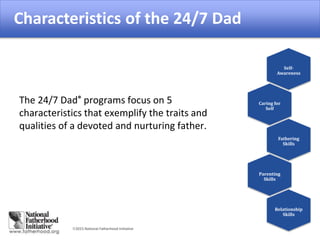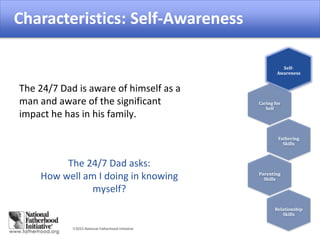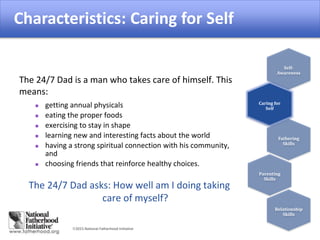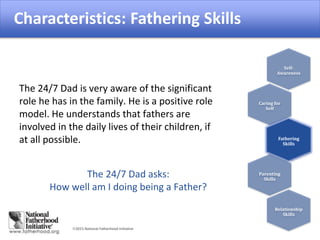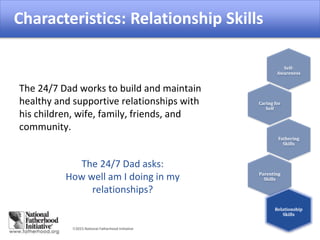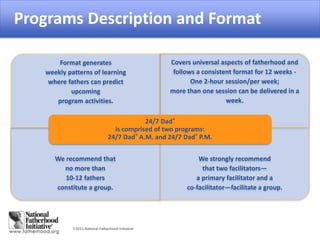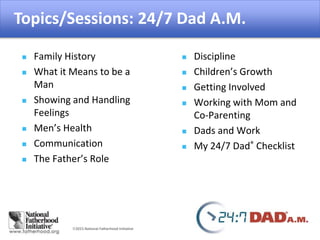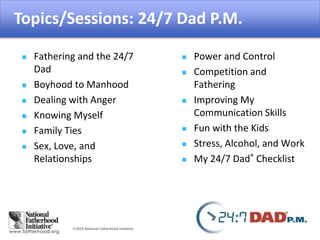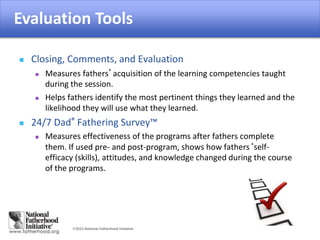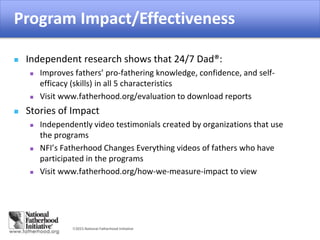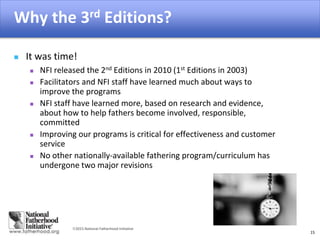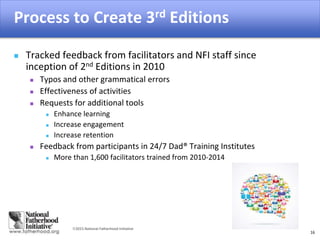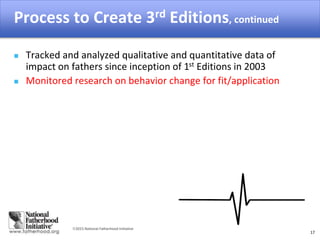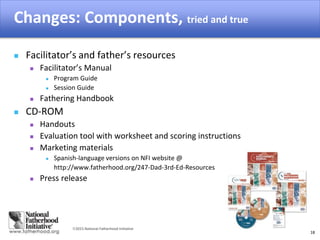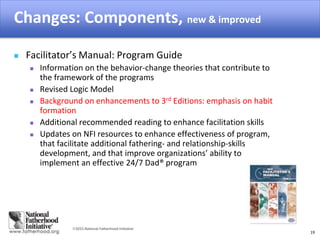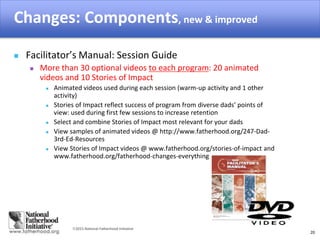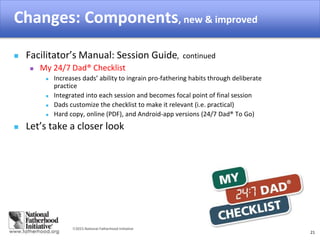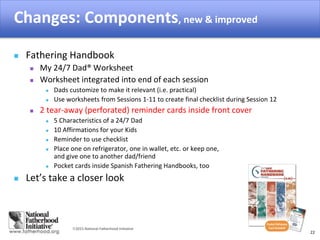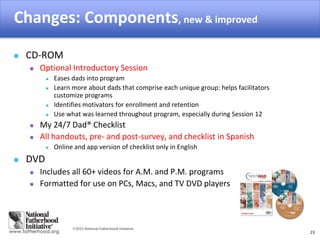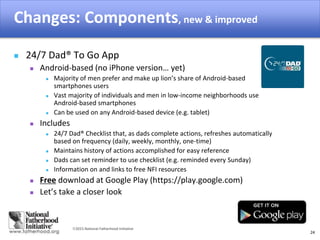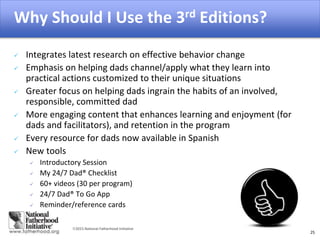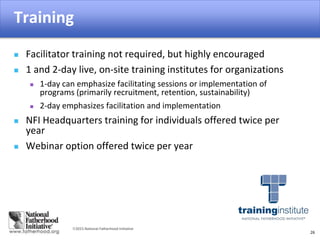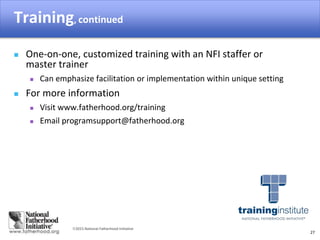24/7 Dad® 3rd Edition Overview
- 1. 2015 National Fatherhood Initiative 1 All About the 24/7 Dad® Programs, Now in their 3rd Edition
- 2. 2015 National Fatherhood Initiative Objectives 2 Brief Overview of the Programs Answer the Questions What hasn’t changed? What’s new and improved? Why should I use the 3rd Edition? Learn About Why NFI created the 3rd Editions Process NFI used to create the 3rd Editions Changes and additions Training on the curricula Cost and how to purchase the curricula
- 3. 2015 National Fatherhood Initiative Characteristics of the 24/7 Dad® The 24/7 Dad® programs focus on 5 characteristics that exemplify the traits and qualities of a devoted and nurturing father. Self- Awareness Caring for Self Fathering Skills Parenting Skills Relationship Skills Characteristics of the 24/7 Dad
- 4. 2015 National Fatherhood Initiative Self-Awareness The 24/7 Dad is aware of himself as a man and aware of the significant impact he has in his family. The 24/7 Dad asks: How well am I doing in knowing myself? Self- Awareness Caring for Self Fathering Skills Parenting Skills Relationship Skills Characteristics: Self-Awareness
- 5. 2015 National Fatherhood Initiative Caring for SelfThe 24/7 Dad is a man who takes care of himself. This means: getting annual physicals eating the proper foods exercising to stay in shape learning new and interesting facts about the world having a strong spiritual connection with his community, and choosing friends that reinforce healthy choices. The 24/7 Dad asks: How well am I doing taking care of myself? Self- Awareness Caring for Self Fathering Skills Parenting Skills Relationship Skills Characteristics: Caring for Self
- 6. 2015 National Fatherhood Initiative Fathering Skills The 24/7 Dad is very aware of the significant role he has in the family. He is a positive role model. He understands that fathers are involved in the daily lives of their children, if at all possible. The 24/7 Dad asks: How well am I doing being a Father? Self- Awareness Caring for Self Fathering Skills Parenting Skills Relationship Skills Characteristics: Fathering Skills
- 7. 2015 National Fatherhood Initiative Parenting Skills The 24/7 Dad is a nurturing parent who clearly understands and accepts the importance his parenting skills have in developing the physical, emotional, intellectual, social, spiritual, and creative needs of his children. The 24/7 Dad asks: How well am I doing being a parent? Self- Awareness Caring for Self Fathering Skills Parenting Skills Relationship Skills Characteristics: Parenting Skills
- 8. 2015 National Fatherhood Initiative Relationship Skills The 24/7 Dad works to build and maintain healthy and supportive relationships with his children, wife, family, friends, and community. The 24/7 Dad asks: How well am I doing in my relationships? Self- Awareness Caring for Self Fathering Skills Parenting Skills Relationship Skills Characteristics: Relationship Skills
- 9. 2015 National Fatherhood Initiative Programs Description & Format Format generates weekly patterns of learning where fathers can predict upcoming program activities. Covers universal aspects of fatherhood and follows a consistent format for 12 weeks - One 2-hour session/per week; more than one session can be delivered in a week. We recommend that no more than 10-12 fathers constitute a group. We strongly recommend that two facilitators— a primary facilitator and a co-facilitator—facilitate a group. 24/7 Dad® is comprised of two programs: 24/7 Dad® A.M. and 24/7 Dad® P.M. Programs Description and Format
- 10. 2015 National Fatherhood Initiative Topics/Sessions: 24/7 Dad A.M. Family History What it Means to be a Man Showing and Handling Feelings Men’s Health Communication The Father’s Role Discipline Children’s Growth Getting Involved Working with Mom and Co-Parenting Dads and Work My 24/7 Dad® Checklist
- 11. 2015 National Fatherhood Initiative Topics/Sessions: 24/7 Dad P.M. Fathering and the 24/7 Dad Boyhood to Manhood Dealing with Anger Knowing Myself Family Ties Sex, Love, and Relationships Power and Control Competition and Fathering Improving My Communication Skills Fun with the Kids Stress, Alcohol, and Work My 24/7 Dad® Checklist
- 12. 2015 National Fatherhood Initiative Structure/Design of Each Session 3 objectives for every session Increase awareness, knowledge, and capacity (skills) Session description What session covers 24/7 Dad characteristics addressed Pre-session procedures Preparing flip charts, materials and handouts, grouping fathers for activities, etc. Each activity Facilitators goal Learning competencies (1-3) for fathers Awareness, knowledge, capacity/skill-building Procedures to carry it out Capacity
- 13. 2015 National Fatherhood Initiative Evaluation Tools Closing, Comments, and Evaluation Measures fathers’acquisition of the learning competencies taught during the session. Helps fathers identify the most pertinent things they learned and the likelihood they will use what they learned. 24/7 Dad® Fathering Survey™ Measures effectiveness of the programs after fathers complete them. If used pre- and post-program, shows how fathers‘self- efficacy (skills), attitudes, and knowledge changed during the course of the programs. Evaluation Tools
- 14. 2015 National Fatherhood Initiative Impact of the Program Independent research shows that 24/7 Dad®: Improves fathers’ pro-fathering knowledge, confidence, and self- efficacy (skills) in all 5 characteristics Visit www.fatherhood.org/evaluation to download reports Stories of Impact Independently video testimonials created by organizations that use the programs NFI’s Fatherhood Changes Everything videos of fathers who have participated in the programs Visit www.fatherhood.org/how-we-measure-impact to view Program Impact/Effectiveness
- 15. 2015 National Fatherhood Initiative Why the 3rd Editions? 15 It was time! NFI released the 2nd Editions in 2010 (1st Editions in 2003) Facilitators and NFI staff have learned much about ways to improve the programs NFI staff have learned more, based on research and evidence, about how to help fathers become involved, responsible, committed Improving our programs is critical for effectiveness and customer service No other nationally-available fathering program/curriculum has undergone two major revisions
- 16. 2015 National Fatherhood Initiative Process to Create 3rd Editions 16 Tracked feedback from facilitators and NFI staff since inception of 2nd Editions in 2010 Typos and other grammatical errors Effectiveness of activities Requests for additional tools Enhance learning Increase engagement Increase retention Feedback from participants in 24/7 Dad® Training Institutes More than 1,600 facilitators trained from 2010-2014
- 17. 2015 National Fatherhood Initiative Process to Create 3rd Editions, continued 17 Tracked and analyzed qualitative and quantitative data of impact on fathers since inception of 1st Editions in 2003 Monitored research on behavior change for fit/application
- 18. 2015 National Fatherhood Initiative Changes: Components, tried and true 18 Facilitator’s and father’s resources Facilitator’s Manual Program Guide Session Guide Fathering Handbook CD-ROM Handouts Evaluation tool with worksheet and scoring instructions Marketing materials Spanish-language versions on NFI website @ http://www.fatherhood.org/247-Dad-3rd-Ed-Resources Press release
- 19. 2015 National Fatherhood Initiative Changes: Components, new & improved 19 Facilitator’s Manual: Program Guide Information on the behavior-change theories that contribute to the framework of the programs Revised Logic Model Background on enhancements to 3rd Editions: emphasis on habit formation Additional recommended reading to enhance facilitation skills Updates on NFI resources to enhance effectiveness of program, that facilitate additional fathering- and relationship-skills development, and that improve organizations’ ability to implement an effective 24/7 Dad® program
- 20. 2015 National Fatherhood Initiative Changes: Components, new & improved 20 Facilitator’s Manual: Session Guide More than 30 optional videos to each program: 20 animated videos and 10 Stories of Impact Animated videos used during each session (warm-up activity and 1 other activity) Stories of Impact reflect success of program from diverse dads’ points of view: used during first few sessions to increase retention Select and combine Stories of Impact most relevant for your dads View samples of animated videos @ http://www.fatherhood.org/247-Dad- 3rd-Ed-Resources View Stories of Impact videos @ www.fatherhood.org/stories-of-impact and www.fatherhood.org/fatherhood-changes-everything
- 21. 2015 National Fatherhood Initiative Changes: Components, new & improved 21 Facilitator’s Manual: Session Guide, continued My 24/7 Dad® Checklist Increases dads’ ability to ingrain pro-fathering habits through deliberate practice Integrated into each session and becomes focal point of final session Dads customize the checklist to make it relevant (i.e. practical) Hard copy, online (PDF), and Android-app versions (24/7 Dad® To Go) Let’s take a closer look
- 22. 2015 National Fatherhood Initiative Changes: Components, new & improved 22 Fathering Handbook My 24/7 Dad® Worksheet Worksheet integrated into end of each session Dads customize to make it relevant (i.e. practical) Use worksheets from Sessions 1-11 to create final checklist during Session 12 2 tear-away (perforated) reminder cards inside front cover 5 Characteristics of a 24/7 Dad 10 Affirmations for your Kids Reminder to use checklist Place one on refrigerator, one in wallet, etc. or keep one, and give one to another dad/friend Pocket cards inside Spanish Fathering Handbooks, too Let’s take a closer look
- 23. 2015 National Fatherhood Initiative Changes: Components, new & improved 23 CD-ROM Optional Introductory Session Eases dads into program Learn more about dads that comprise each unique group: helps facilitators customize programs Identifies motivators for enrollment and retention Use what was learned throughout program, especially during Session 12 My 24/7 Dad® Checklist All handouts, pre- and post-survey, and checklist in Spanish Online and app version of checklist only in English DVD Includes all 60+ videos for A.M. and P.M. programs Formatted for use on PCs, Macs, and TV DVD players
- 24. 2015 National Fatherhood Initiative Changes: Components, new & improved 24 24/7 Dad® To Go App Android-based (no iPhone version… yet) Majority of men prefer and make up lion’s share of Android-based smartphones users Vast majority of individuals and men in low-income neighborhoods use Android-based smartphones Can be used on any Android-based device (e.g. tablet) Includes 24/7 Dad® Checklist that, as dads complete actions, refreshes automatically based on frequency (daily, weekly, monthly, one-time) Maintains history of actions accomplished for easy reference Dads can set reminder to use checklist (e.g. reminded every Sunday) Information on and links to free NFI resources Free download at Google Play (https://play.google.com) Let’s take a closer look
- 25. 2015 National Fatherhood Initiative Why Should I Use the 3rd Editions? 25 Integrates latest research on effective behavior change Emphasis on helping dads channel/apply what they learn into practical actions customized to their unique situations Greater focus on helping dads ingrain the habits of an involved, responsible, committed dad More engaging content that enhances learning and enjoyment (for dads and facilitators), and retention in the program Every resource for dads now available in Spanish New tools Introductory Session My 24/7 Dad® Checklist 60+ videos (30 per program) 24/7 Dad® To Go App Reminder/reference cards
- 26. 2015 National Fatherhood Initiative Training 26 Facilitator training not required, but highly encouraged 1 and 2-day live, on-site training institutes for organizations 1-day can emphasize facilitating sessions or implementation of programs (primarily recruitment, retention, sustainability) 2-day emphasizes facilitation and implementation NFI Headquarters training for individuals offered twice per year Webinar option offered twice per year
- 27. 2015 National Fatherhood Initiative Training, continued 27 One-on-one, customized training with an NFI staffer or master trainer Can emphasize facilitation or implementation within unique setting For more information Visit www.fatherhood.org/training Email programsupport@fatherhood.org
- 28. 2015 National Fatherhood Initiative Cost 28 Pre-release $449 per kit through February 5th ($200 off) Use the savings to purchase the A.M. program w/booster sessions for non-custodial dads! $599 for the 24/7 Dad® A.M. Kit with booster sessions After-release $549 through March 31st ($100 off) Regular pricing $649 starting April 1st NFI will continue to sell 2nd Edition handbooks through December 31, 2015 To purchase, visit www.fathersource.org


